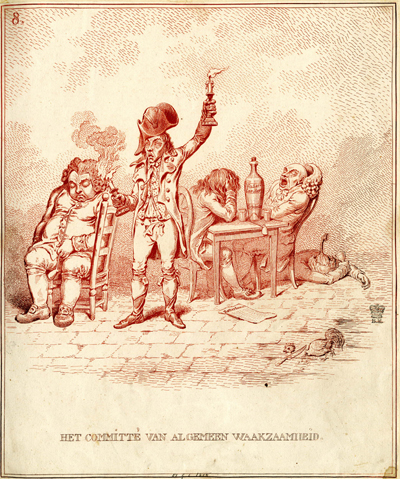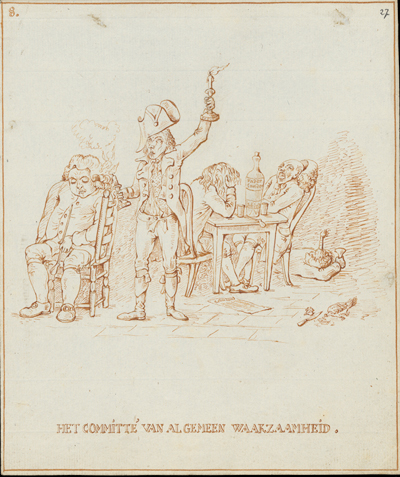Het Committé van Algemeen Waaksaamheid
This is the eighth plate of a twenty plate series, Hollandia Regenerata, etched by Gillray based on drawings by the Swiss soldier, painter, and caricaturist, David Hess. For more about David Hess, and the political and artistic context of the series satirizing the newly-created and French-supported Batavian Republic, see my Introduction.
The title can be translated as "The Committee of General Vigilance." And, of course, what the print shows is a committee which is anything but vigilant. The fat man on the left has fallen asleep in his chair with his clay pipe in hand. On the right, two other committee members sleep before a table with an oversized bottle of Schiedam, a synonym for Holland gin in the 18th century. One of them snores open-mouthed as his wig falls off. On the floor next to them, another man has passed out, glass in hand. In the right forgeound, a would-be crowing cock has had its throat cut lest it disturb the slumbers of the committee. The only figure still standing is a disheveled and tipsy-looking man, eyes mostly closed, with two candles in his hands "appropriated" from the belongings of the Prince of Orange (P.V.O.). According to Joost Rosendaal whose "Nawoord" to his facsimile edition of Hollandia Regenerata is essential reading for anyone interested in the series, this man likely represents Hugo Gevers, one of the leading revolutionaries and a member of this committee.

Het
Committé van Algemeen Waaksaamheid
[1796?]
© Trustees of the British Museum
As with all the plates in the series, the corresponding page to the image contains one or more appropriately ironic Biblical quotations in Dutch and English and a satiric "Explanation" in French. The Biblical quotation is wonderfully appropriate to the seeming narcolepsy of the comittee members:
Isaiah, xxix. 10. "The Lord hath poured out upon you the spirit of deep sleep, and hath closed your eyes: the prophets and your rulers, the seers, hath he covered."
The heavily ironic "Explanation", puts an appropriately disingenuous spin on what is shown in the image. Here is the French text of the "Explanation."
Apres avoir veillé longtems pour le bien de l'etat, un moment de repos fait plaisir. Les citoyens de ce Committé ont bien fait de couper le cou à ce coq vigileant, il aurait pu, avec ses cris, interrompre leur doux sommeil.—Et cette tête volcanisée, qui somnambulise par la chambre, ferait bien mieux de se coucher, que d'allumer la peruque de l'honête homme qui ronfle si paisiblement sur sa chaise.
And here is my free English translation.
After a lengthy watch for the good of the state, a moment of rest is welcome. The citizens of this Committe did well to cut off the head of the vigilant cock; for he could have, with his cry, interrupted their sweet slumbers. And the sleepy man with candles in hand would be much better served to lie down than to light the wig of the honest man snoring so peacefully in his chair.
But there are two other details in the print—the list on the floor with the heading "Rotterdam" and the accidental fire being set off by the man with the candles—that may have a more specific meaning.
As Simon Schama points out in his book Patriots and Liberators, the Batavian Revolution was hardly a simple and univocal movement. Even apart from the opposition of Patriots (sympathetic to the Revolution) and Orangists (still faithful to the old Prince of Orange), there were disagreements and divisions even within the revolutionaries themselves, especially with regard to the power which ought to be delegated to the people and the treatment of Orangists. One group wanted a more thoroughgoing democracy in which power extended to the lower classes and in which traitors (like the Orangists) would be punished. Another group wanted a more moderate approach in which power was still centered in the upper classes and which took a more forgiving approach to former Orangists.
One of the most conspicious flashpoints in this debate took place on June 14, 1795 in Rotterdam when, as described by Simon Schama,
a large, noisy, and, according to many witnesses, liberally intoxicated crowd assembled in front of the Stadhuis demanding the arrest of the head sheriff of the city . . .vilified as the arch-reactionary of 1787 and 1788. The crowd also insisted on a purge from top to bottom of every public official who had held a post between 1787 and 1795. . . . For several hours the Stadhuis remained beseiged while the municipality sweated within over whether to call out the city militia to restore order.
The two column list on the floor with the heading "Rotterdam" likely refers to this event and the fire within the committee itself may suggest the inadvertent threat to public safety created by an administration more than half asleep when it should be vigilant.

Het
Committé van Algemeen Waaksaamheid
[1796?]
© Zentralbibliothek Zürich
As in most of the plates of Hollandia Regenerata, Gillray follows the Hess's drawing very closely. The disposition of the figures and the details and meaning of the print all derive from Hess, but Gillray has sharpened every line and, with a wonderful use of shading, given a depth and solidity to the background, foreground, and figures (especially their clothes) that is missing in the original Hess drawing.
Sources and Reading
- Commentary from the British Museum on Het Committé van Algemeen Waaksaamheid.
- "Batavian Republic," Wikipedia
- "David Hess (painter)," Wikipedia
- "David Hess," SIKART Dictionary
- David Hess, Hollandia Regenerata (1797), Nawoord by Joost Rosendahl, Uitgeverij Vantilt, 2007
- Simon Schama, Patriots and Liberators: Revolution in the Netherlands 1780 - 1813, London, 1992
- Ralph Fell, A Tour Through the Batavian Republic
Comments & Corrections
NOTE: Comments and/or corrections are always appreciated. To make that easier, I have included a form below that you can use. I promise never to share any of the info provided without your express permission.